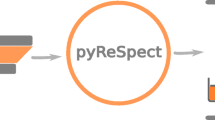Abstract
A computer algorithm is described which allows the determination of a discrete distribution of relaxation times from simulated or smoothed storage or loss modulus data, or of retardation times from simulated or smoothed storage or loss compliance data. The distributions faithfully reproduce the input data and are suitable for data storage as well as for generating any other response curves.
Similar content being viewed by others
References
Emri I, Tschoegl NW (1993a) Generating line spectra from experimental responses. I. Relaxation modulus and creep compliance. Rheol Acta 32:311–321
Emri I, Tschoegl NW (1993b) Generating line spectra from experimental responses. IV. Application to experimental data. To be submitted to Rheol Acta
Tschoegl NW (1989) The phenomenological theory of linear viscoelastic behavior. Springer, Berlin
Tschoegl NW, Emri I (1992) Generating line spectra from experimental responses. III. Interconversion between relaxation and retardation behaviour. Intern J Polym Mater 18:117–127
Author information
Authors and Affiliations
Rights and permissions
About this article
Cite this article
Tschoegl, N.W., Emri, I. Generating line spectra from experimental responses. Part II: Storage and loss functions. Rheola Acta 32, 322–327 (1993). https://doi.org/10.1007/BF00434196
Received:
Accepted:
Issue Date:
DOI: https://doi.org/10.1007/BF00434196




